The drawbacks of electric vehicles are clear to anyone that's paying attention, recited whenever the new-energy vehicles come up. Those complaints are drying up, including the ones about speed and comfort, but there's one that won't go away: subzero temperatures decimate the range of lithium-ion batteries.
That is true. At 32 degrees Fahrenheit when driving at a steady state a battery can lose 20 percent of its driving range, according to HERE Technologies. The Norwegian Automobile Federation found the same result, but noted that percentage varies by model. In small daily trips in subzero temperatures, it can lose far more. For instance, the Audi e-tron GT lost 16 percent of its range, the BMW i4 M50 lost 19 percent, the Tesla Model 3 lost 23 percent and the Volkswagen ID.4 lost 15 percent.
And so it was with the 2024 Nissan Leaf, an EV that was refreshed last year with a new front end including grille, headlights and wind deflectors, new wheels and a new rear spoiler.
It comes with a choice of two powertrains. The 2024 Leaf S has a 40-kWh lithium-ion battery and 110-kW electric motor that delivers 147 horsepower (hp) and 236 pound-feet (lb-ft) of torque and up to 149 miles of range. The Leaf SV Plus tested here had a larger 60-kWh lithium-ion battery with a range of up to 212 miles. Its electric motor sends 214 hp and 250 lb-ft to the front wheels.
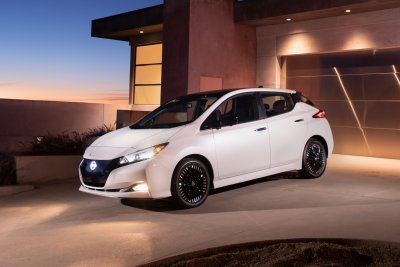
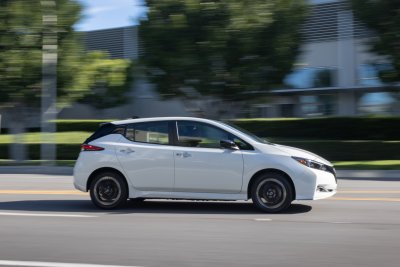
Under normal circumstances at a 240-volt home charger both the S and SV Plus will recharge fully in 11.5 hours. On a DC fast charger it takes 40 minutes to regain 80 percent charge on the S and 60 minutes to get that in the Plus.
It landed in the driveway with 177 miles of range on a 14-degree Fahrenheit day. After a quick 40-mile roundtrip, it was down almost 80 to 105 miles. The range does increase when put in Eco driving mode, and with the heat off, though that wasn't an option during the week. That Eco mode desensitizes the accelerator so the driver doesn't use extra energy.
After a few more local trips it was still nerve-wracking to drive to the charger, not knowing for sure if it would be in service as sometimes the EV charger apps don't give the correct information.
Thankfully the EVGo charger was in service and I was able to quickly connect and pay. Unfortunately, the Leaf SV Plus electrical system only allows it to charge at 100 kilowatts (kW) on a DC fast charger (the Leaf S tops out at 50 kW), and in that frigid weather it only topped out at 25 kW. That meant 30 minutes of charging only returned 60 miles, although that was good enough to get through the rest of the week.
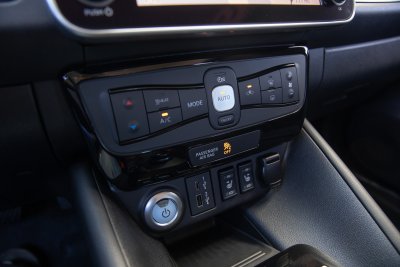
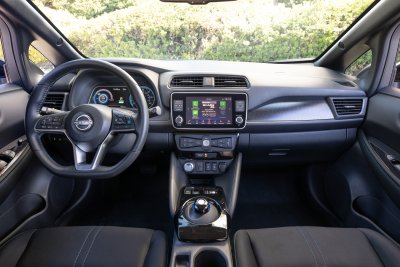
And that's important. Buyers need to be honest with themselves about the vehicle, and honest about whether they're going to have a home charger installed, which more than 80 percent do. All of the problems mentioned above go away with a home charger, including the cabin heat. With preconditioning software accessed through the app, the cabin would already be warm and range would improve even further.
Compounding the problem of 12-degree weather, the Leaf doesn't have a heat pump like other EVs like the Polestar 2 and Tesla Model 3, which compresses excess heat from the battery and electrical systems, along with air outside the car, at high pressure. The heat produced warms up both the battery (to operating temperature) and cabin air.
Additionally, many households have two cars. If a family like that did own an electric vehicle, and wanted to drive from Metro Detroit to Florida, they would likely just take the other vehicle. For an overwhelming majority of the time, one five-passenger 212-mile Nissan Leaf would suit one person's needs, even with a family.
It's better than expected in the snow with front-wheel drive and narrower tires that cut through the slush. It's not slow either in Normal mode, with all of its 250 lb-ft of electric torque active from a standstill. Though it is quick to momentarily lose traction from a standstill when accelerating on wet pavement.

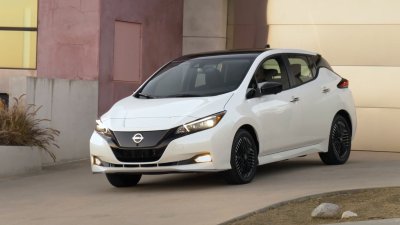
It doesn't feel as solid or insulated as some more expensive EVs but the handling is accurate and the suspension is compliant for daily use. Eco mode improves mileage as does the E-Pedal, which brings the car to a stop when the accelerator is lifted.
Inside, black cloth is standard on both trims; the Leaf S has gray trim and the SV Plus has gloss black. The Leaf has a 60/40 folding rear seat with seatbelts that were easy for children to use. Compared to most vehicles on the road it was also easy for children to enter. With only two booster seats and two kids there is plenty of space for reachable cargo, in addition to the 23 cubic feet of storage space behind the second row.
It does come with Nissan's new Zero Gravity front seats, which help alleviate fatigue for drivers and passengers with an ideal posture developed by NASA. In a weightless scenario, Nissan says, human posture is weakened and the burden on the body is at its least, meaning posture does not collapse even over long periods. It applied that neutral posture to a car seat, aiming to leave drivers refreshed after a long trip.
The 2024 Nissan Leaf has an 8-inch touchscreen infotainment display. It comes with Apple CarPlay and Android Auto as standard while the SV Plus trim includes navigation. NissanConnect EV and services is also standard, which allows a remote connection to the vehicle to start a charge, monitor the state of a charge and turn on the heat or A/C before ever getting into the vehicle.
The Leaf has the usual array of safety features including emergency braking and forward collision warning, blind spot indicators and rear-cross traffic alert. Additionally, the Leaf SV PLUS comes with ProPILOT Assist, a hands-on driver assist system that combines Nissan's Intelligent Cruise Control and steering assist to keep the car within its lane and to stop and go with traffic.
The 2024 Nissan Leaf starts at just $28,140, making it one of the least expensive new EVs you can buy. Additionally, Nissan has been able to certify that the 2024 Leaf meets battery component requirements of the Inflation Reduction Act and qualifies for the $3,750 tax credit.
It's only other real competitor is the outgoing Chevrolet Bolt and Bolt EUV, which have prices of $26,500 and $27,800. They all have more than 200 miles of range and all are perfectly adequate for 95 percent of daily driving duties. The Tesla Model 3 is also cross shopped. That EV has a range of 272 or 341 miles and a base price of $38,990 for the Standard Range model. With the $3,750 credit that it now qualifies for that price is reduced to $35,240. However, leases qualify for the full $7,500 tax credit so there's more money to be saved that way as well.
And that's the key. EV's won't solve every family's transportation needs, but for those who can roll a charger in to the price of purchase, and/or get a credit from their local energy provider, it could be the only household vehicle most days of the month. When that road trip vacation comes, there are great deals on minivan rentals, which is the best way to take a road trip anyway.
Uncommon Knowledge
Newsweek is committed to challenging conventional wisdom and finding connections in the search for common ground.
Newsweek is committed to challenging conventional wisdom and finding connections in the search for common ground.
About the writer
Jake Lingeman is the Managing Editor for the Autos team at Newsweek. He has previously worked for Autoweek, The Detroit ... Read more
To read how Newsweek uses AI as a newsroom tool, Click here.








